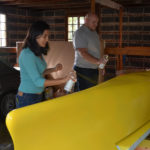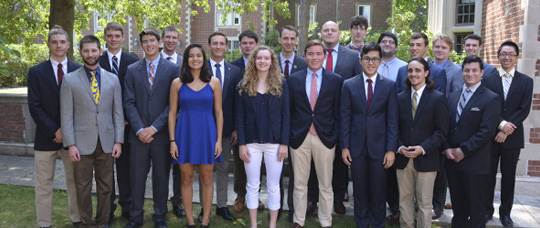Seaworthiness of an Autonomous Vessel: An Investigation of Viscous Effects on a SWATH in Roll-Inducing Waves
Andrew Arnold & Ian Cho
A SWATH geometry has been designed to serve as the hull of an autonomous vessel. It must have an appropriately limited roll response for the wave profile it will encounter in order to satisfy its mission. Our thesis tests this hull design in its must unfavorable roll condition, with beam seas exciting a response over a range of encounter frequencies. The vessel is tested at zero forward speed in both Webb’s Robinson Model Basin and the CFD program STAR-CCM+. In our experimentation, the vessel is free to move within six degrees of freedom so that measured responses are coupled and more accurately represent reality. The response equation is determined through these two methods and the results are compared and interpreted.
Testing of a Ducted Propeller with Varied Nozzle Geometry
Alexander Bashkoff & Tim Siepmann
This thesis consists of building a structural modification for the existing Webb Propeller Boat to allow for a nozzle to be supported around a propeller. We will verify our model by using a duct and propeller that MARIN previously tested, and then we will vary the size of the nozzle keeping the same Kaplan propeller to test for thrust efficiency. The structure is primarily aluminum, and the nozzles and propeller will be 3D-printed.
Modeling a Hydrogen-based, Renewable Energy Storage System in MATLAB and Simulink
Spenser Boyd
Renewable energy is becoming more common, but challenges exist in enabling renewables to become widespread and cost effective. Effective grid energy storage can relieve some of the challenges facing variable renewables and strengthen the grid as a whole. This thesis will design a hybrid hydrogen storage system and attempt to prove its feasibility through computer simulation and analysis in MATLAB/Simulink. The system will be modeled with realistic parameters, simulated under realistic operating conditions, and its performance evaluated. Additionally, a brief economic analysis will be performed to evaluate the feasibility of system implementation relative to other grid energy storage solutions.
Effects of Varying Side-hull Spacing and Longitudinal Stagger on Tri-SWACH Seakeeping
Spencer Dugan & James Morrissey
This thesis performs a seakeeping analysis of the Tri-SWACH hull form with various longitudinal stagger and transverse spacing of the side-hulls. The objective of the thesis is to determine the optimal configuration of the side-hulls for seakeeping performance, specifically the vertical accelerations limited to motions in pitch and heave. The thesis also involves the use of a potential flow code, WASIM, to simulate the model’s response. The results of both analyses will be compared with NATO’s Common Procedures for Seakeeping in the Ship Design Process to determine whether the model is compliant.
Converting Vortex-Induced Vibration Into Useful Energy: An Investigation of the Dynamics of a Self-Exciting Elastically Mounted Foil
Alexander Dzinbal, Joseph Gargiulo, & Ian Lawson
This thesis will develop a reliable apparatus for testing the dynamics of elastically-mounted foils in the Webb Flow Channel. The apparatus is a highly-configurable platform with interchangeable components that provides variable stiffness and damping in two degrees of freedom, heave and pitch. We will use the apparatus to analyze the ability of a blunt foil to convert vortex-induced vibrations into power by measuring the time history of heave and pitch motions across a range of operating conditions. Future theses will be able to adapt our apparatus for additional investigations of hydrodynamic properties.
Comparing the Sensitivity of 3D-Printing and Additive Manufacturing to Printing Orientation
Ryan Fagan
This thesis aims to analyze the strength characteristics of 3D-printed and additive manufactured parts. The goal is to find which printing orientation produces the best strength properties in these pieces. Pieces will be made in each printing orientation using both a plastic-based 3D-printer and a metal-based additive manufacturer which will then be tensile tested and compared to each other. Finite-element analysis models will also be used to verify test results. The objective of this thesis is to provide insight on the differences of these new manufacturing technologies and help facilitate future rapid prototyping.
A Physical Model Comparison to HECSALV: Asymmetric and Partial Flooding of an S-175 Stability Hull
Wm. Marshall Fettig & Brianna Louie
 The objective of this project is to design, build, and test an accurate, floodable, physical, damage-stability model for Webb use. This model will provide one of the major components necessary for research in the field of damage stability. The model will be of adequate size to test in Webb’s Robinson Model Basin or the Long Island Sound. The commercial damage stability software, HECSALV, produced by Herbert-ABS Software Solutions, will be used to model the vessel virtually and tune the physical model. This virtual model will also be made available to the Institute for use in future thesis work. Additionally, a thorough exploration of the survivability and hydrostatic responses of an S175 stability hull-form in various symmetric and asymmetric damage conditions will be undertaken. The intention of these experiments will be to verify the accuracy of the model when compared with the virtual ship model. The S175 stability hull in question was generously loaned to Webb Institute by the United States Naval Academy (USNA) Hydrodynamics Laboratory for this purpose.
The objective of this project is to design, build, and test an accurate, floodable, physical, damage-stability model for Webb use. This model will provide one of the major components necessary for research in the field of damage stability. The model will be of adequate size to test in Webb’s Robinson Model Basin or the Long Island Sound. The commercial damage stability software, HECSALV, produced by Herbert-ABS Software Solutions, will be used to model the vessel virtually and tune the physical model. This virtual model will also be made available to the Institute for use in future thesis work. Additionally, a thorough exploration of the survivability and hydrostatic responses of an S175 stability hull-form in various symmetric and asymmetric damage conditions will be undertaken. The intention of these experiments will be to verify the accuracy of the model when compared with the virtual ship model. The S175 stability hull in question was generously loaned to Webb Institute by the United States Naval Academy (USNA) Hydrodynamics Laboratory for this purpose.
A Computational Fluid Dynamics Analysis of Vessel Squat in Shallow Water and Restricted Channels
Michael Imbesi
This thesis will investigate a series of anomalous squatting incidents in the Delaware Bay, where vessels seemed not to be acting as their squat tables would seem to indicate, specifically in the shipping channel. The aim is to use the potential flow code Aegir to try to determine a probable cause for this behavior. The study of shallow water squat is full of empirical approximations but has almost no actual data or theory to corroborate these approximations. The result is that the phenomenon’s effects on ships are not well understood. For this reason, we are using Aegir to investigate these incidents.
The Design and Construction of a Multipurpose Autonomous Surface Vessel
Isaac Kremers
This thesis involves the development of a platform for Webb to be used for future Autonomous Surface Vessel (ASV) research and development. Factors that go into ASV design such as potential missions, navigational laws, range and endurance, stability, and vessel capabilities will be investigated. It is important that the vessel can be repurposed for future missions; therefore, a reasonable payload margin and configurable deck layout must be incorporated. Trade-offs between different designs will be analyzed. The vessel will have autonomous and operator-controlled functionality. Its control and navigation software will remain open-source for further development. The initial mission of the vessel will be to seek out oil spills in the Long Island Sound.
Numerical Analysis of Seakeeping Data on Planing Hulls: Using Artificial Neural Networks to Interpret Tank Data
Jonathan Roussin
This thesis investigates the application of artificial neural networks to seakeeping characteristics of planing hulls. Model test data were graciously provided by Donald L. Blount and Associates. The model testing program studied the effect of curvature in the after buttocks on the motions and accelerations of planing craft in irregular seas. Provided model data were interpolated and optimized using Neural Solutions software. The network architecture is optimized to improve trend fitting using Taguchi’s Design of Experiment, which allows the neural network to be statistically optimized without testing all possible configurations of the network.
A Study on the Effects of Long-Term Exposure to Cold Temperatures on the Fracture Properties of High Strength Steel
Aaron Tam
The fracture of structural steel is one of the greatest concerns for ships and offshore structures operating in polar regions like the Arctic. This thesis examines the fracture properties of high strength steel from the Mobile Offshore Drilling Unit (MODU) Kulluk, an offshore structure that operated in the Arctic for 17 years. Data will be gathered from Kulluk steel samples through Charpy V-notch impact testing and microstructure analysis. The fracture properties will be determined, analyzed, and compared to the steel’s initial properties to determine any change in fracture strength.
An Optimization of the Semi-Elliptical Catamaran Hull Form
Barr Turner Jr. & Hannah Wistort
The primary objective of this thesis is to optimize the semi-elliptical catamaran hull form developed by Professor Jacques Hadler in 2005. The semi-elliptical catamaran minimizes frictional resistance by utilizing semi-elliptical sections to form a hull with the lowest possible wetted surface area for a given volume. This thesis will determine the optimal length-to-beam and beam-to-draft ratios for this hull form. The optimization will be performed using AEGIR, a potential flow code program. Results of this computational testing will be compared to both systematic catamaran series and previous thesis work. Once a hull form with the optimum parameters is selected, a fiberglass model will be built and tested in Webb’s Robinson Model Basin to verify computational results.

